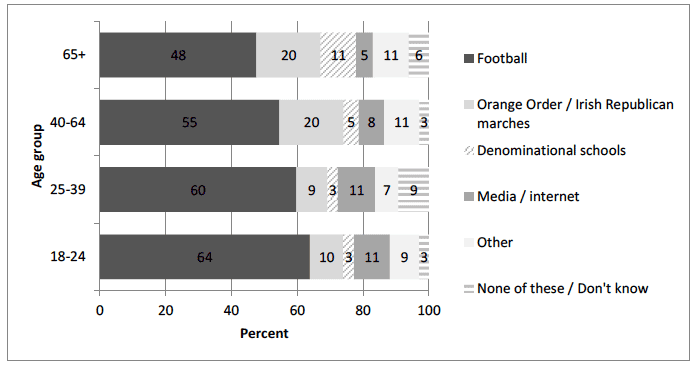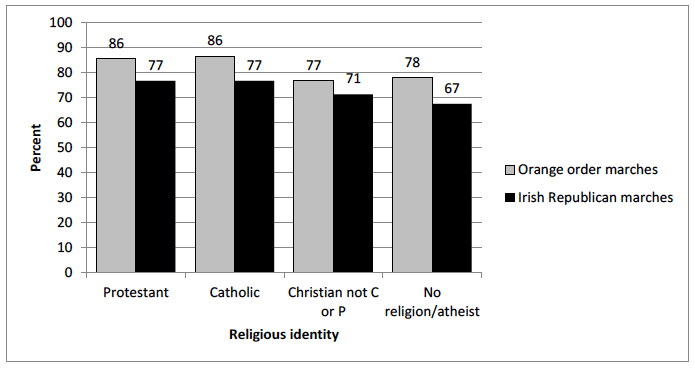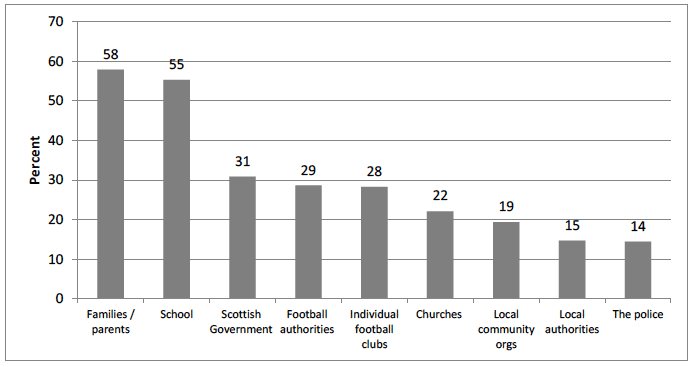Scottish Social Attitudes Survey 2014: Public Attitudes to Sectarianism in Scotland
This report sets out key findings from the 2014 Scottish Social Attitudes survey (SSA) on public attitudes to sectarianism in Scotland.
This document is part of a collection
4 Perceptions of Responsibility for Sectarianism
Key points
- Football is the most commonly mentioned factor people believe contributes to sectarianism in Scotland (88% mentioned it, and 55% thought it was the main factor).
- The next most commonly mentioned contributory factors were loyalist (including Orange Order) marches (79% mentioned it, and 13% thought it the main factor) and Irish Republican marches (70% mentioned it, and 3% thought it the main factor).
- Around a third thought each of denominational schools[1], the internet and social media, and more traditional media contributed to some extent to sectarianism in Scotland.
- Families (58%) and schools (55%) are most commonly viewed as best placed to tackle sectarian attitudes in Scotland, perhaps suggesting public support for a grass-roots, rather than a top-down approach to tackling sectarianism. However, 50% also view either football clubs or football authorities as having a role in this respect.
- Although fewer people view the Scottish Government (31%), churches (22%), local community organisations (19%), local authorities (15%) or the police (14%) as best placed to tackle sectarian views, the fact that no one organisation or group attracted an overwhelming majority suggests that the public may support an approach that involves multiple organisations in tackling sectarianism.
- The public is divided on whether the Scottish Government gives the right amount of attention to sectarianism (47%) or too little (31%). Only 10% thought they gave it too much attention.
4.1 This chapter explores perceptions of responsibility for sectarianism from two angles. First, it looks at responsibility in terms of who or what people believe contributes to sectarianism in Scotland. Second, it considers who the public think is best placed to tackle sectarianism, and whether or not people think the Scottish Government focus the right amount of attention to sectarianism as an issue.
What do people think contributes to sectarianism?
4.2 The 2003 report on attitudes to sectarianism in Glasgow (NFO, 2003) found that discussion of sectarianism in focus groups often focused on Rangers and Celtic football clubs. The media was blamed by some for stirring up feelings around Old Firm games. Others discussed the history of the clubs, the symbolism that surrounds them, and the activities of supporters or organisations who associate themselves with the clubs, all of which feed in to the perceptions of the clubs as being associated with Loyalist and Republican divisions in Ireland. There was no consensus, however, as to how much of the trouble around such matches was grounded in sectarianism, and how much was simply down to football rivalries. Catholic schools were also identified in these focus groups, not so much as being a direct cause of sectarianism, but as something that made religious difference appear common and thus as potentially sustaining sectarian sentiment more widely. Links between sectarianism in Scotland and Irish politics were also raised, particularly with respect to Orange Order and Irish Republican marches, with both of these seen as intimidating and symbolic of religious intolerance.
4.3 Respondents to SSA 2014 (with the exception of those who had said that sectarianism is not a problem in Scotland at all, 8% of all respondents), were asked:
From what you have seen, read or heard, which of these, if any, would you say contribute to sectarianism in Scotland?
4.4 They were given a list of 12 responses (listed in Table 4.1), and asked to choose all that apply. To limit any bias introduced from the ordering of the list, the order in which options were presented was reversed for half the sample. Where more than one answer was provided, respondents were asked to say which they thought contributed the most.
4.5 As Table 4.1 shows, football is viewed by a majority of people in Scotland as the main contributor to sectarianism. Among those who viewed sectarianism as a problem, 55% thought that football was the main contributor (a far higher proportion than picked any other options), while 88% thought it contributed to some extent.
4.6 Ties with Ireland, through Orange Order and Irish Republican marches, or through events in Ireland were also considered as significant contributors by many. 79% said that Orange Order marches contributed, 70% mentioned Irish Republican marches, and 51% mentioned events in Ireland. Given the more common occurrence of Orange Order marches in Scotland, it is perhaps not surprising that more thought that Orange Order marches were the main factor contributing to sectarianism (13%) than attributed it to Irish Republican marches (3%).
4.7 Of the other options presented to respondents (see Table 4.1), just over a third mentioned each of denominational schools; the internet and social media; and newspapers, television or radio as contributing to sectarianism. Just over a quarter mentioned churches. Relatively few people (5% or less in each case) considered each of these to be the factor that contributed most to sectarianism in Scotland.
Table 4.1: Perceptions of what contributes and what contributes most to sectarianism in Scotland
| Contributes | Contributes most | |
|---|---|---|
| Football | 88 | 55 |
| Orange Order marches | 79 | 13 |
| Irish Republican marches | 70 | 3 |
| Events in Ireland | 51 | 4 |
| Denominational schools | 37 | 5 |
| The internet and social media | 37 | 4 |
| Newspapers, television or the radio | 34 | 4 |
| Churches | 27 | 3 |
| Non-denominational schools | 8 | * |
| The police | 8 | * |
| Rugby | 3 | * |
| Golf | 1 | 0 |
| Other | 4 | 2 |
| None of these | * | 1 |
| Don't know | 3 | 4 |
| Sample size | 1385 | 1385 |
Those who said sectarianism is not a problem at all in Scotland were not asked this question
* indicates less than 0.5%, but greater than 0, whereas a 0 indicates no one in the sample gave this answer
Variations in views of what contributes to sectarianism
4.8 The extent to which particular factors were seen as contributing to sectarianism varied significantly depending on people's age, religious identity, geographical location, schooling and family and social ties.
4.9 Younger people were more likely to mention both traditional and social media as contributing factors to sectarianism in Scotland today. 56% of those aged 18-24 mentioned the internet and social media, declining to 15% of those aged 65 and above. The pattern for more established media was not quite so stark, but there was still a clear difference, with 43% of the younger age group mentioning newspapers, television or radio, compared with 26% of those in the oldest group.
4.10 Young people were also more likely than older people to view football as the main contributor to sectarianism (64% of 18-24 year-olds compared with 48% of those aged 65 or older). Older people, in contrast, were more likely to attribute sectarianism primarily to denominational schools (11% of those aged 65 and above, compared with 3% of those aged 18-39). Those aged 40 or older were also more likely to see either Orange Order or Irish Republican marches as the main contributor (20%), compared with 10% of those aged 18-39 (Figure 4.1).
Figure 4.1: Perceptions of what contributes the most to sectarianism, by age

Sample size: 18-24=87; 25-39=284; 40-64=621; 65+=391
Excludes those who said sectarianism is not a problem at all in Scotland
The main 'other' responses were 'events in Ireland' (between 3% and 6%) and churches (between 2% and 4%)
4.11 Those who did not identify with any religion were more likely than religious people to think that churches contributed to sectarianism in Scotland (39% of those with no religion, compared with 22% of Protestants, 14% of Catholics and 24% of those who were Christian but not Catholic or Protestant). Lapsed Christians (who were brought up as Christian but did not now belong to any church) were just as likely to view churches as responsible as those who had never belonged to any faith. Loss of faith and lack of faith thus seem equally associated with a greater tendency to lay some of the blame for sectarianism at the door of Scotland's churches.
4.12 In contrast, those who identified as Protestant or Catholic were both more likely to identify marches as contributing to sectarianism than were those who did not identify themselves with either of these faiths. 86% of both Protestants and Catholics who recognised sectarianism as a problem in Scotland thought that Orange Order marches contributed, compared with 77% of other Christians and 78% of those identifying with no religion. Similarly, 77% of both Protestants and Catholics thought that Irish Republican marches contributed, compared with 71% of other Christians and 67% of non-believers. Those with close friends or family members who are Protestant were also more likely than those who do not know anyone who is Protestant to view marches (both Orange Order and Irish Republican) as a contributing factor. The pattern by having friends or family who are Catholic was not as clear. However, these findings perhaps suggest that being either Catholic or Protestant or having close ties with those who are is associated with a heightened awareness of marches which may, in turn, be associated with a more critical view of their perceived association with sectarianism.
Figure 4.2: Perceptions of whether marches contribute to sectarianism, by religious identity

Sample size: Protestant=485; Catholic=186; Other Christian=227; No religion=438
Excludes those who said sectarianism is not a problem at all in Scotland
4.13 The previous chapter indicated that around a third of people perceive sectarianism to be an issue primarily in Glasgow and the West of Scotland. However, people living in these areas do not view the contributors to sectarianism particularly differently from those living in other parts of Scotland. As in the rest of Scotland, football was the most common factor mentioned by people in the West (88%, the same as for Scotland as a whole). The proportion of those living in the West who identified Orange Order (83%) or Irish Republican marches (75%) as contributing was also not statistically significantly different from the proportions in other parts of Scotland who mentioned these (77% and 67% respectively).
4.14 Having family connections to Ireland was associated with being more likely to think Irish Republican marches contribute to sectarianism in Scotland (80%, compared with 67%). There was no such association with Orange Order marches. Perhaps those with family ties to Ireland hold particular views on the role of Irish Republicanism in sectarianism in Ireland which find parallels in their opinion of the role of Irish Republican marches in Scotland. Family connections to Ireland were also associated with thinking events in Ireland contribute to sectarianism (58% of those with a connection to Ireland, compared with 49% of those without).
4.15 It might be expected that those who support football would be less critical of its role in relation to sectarianism. However, in fact the opposite is true - football fans were if anything slightly more likely to perceive football as a contributing factor (92% of supporters of any Scottish football club, compared with 84% of those who did not support one). There was no significant difference between supporters of the Old Firm and other clubs. Perhaps those who have witnessed first-hand sectarian chanting or songs on the terraces are even more inclined to see their sport as having some role to play in sustaining sectarian attitudes and behaviours in Scotland.
4.16 In contrast, experience of denominational schooling appears to make people less inclined to view such schools as contributing to sectarianism in Scotland - 25% of those who attended a denominational school thought they contributed, compared with 40% of those who did not.
Perceptions of who is best placed to tackle sectarianism
4.17 The 2003 Glasgow report explored how people thought that sectarianism should be tackled. Many of the suggestions in that report related to football. Some of these, for example, concerning sectarian chanting at football matches, have already been the subject of government action (via the Offensive Behaviour at Football Act). Education, including campaigns aimed at the general public, was also seen by many as important in tackling sectarianism, while churches were seen as having only a limited role in this respect.
4.18 In order to explore who people think is best placed to tackle sectarianism, SSA 2014 asked:
Some people think it is important to address sectarian attitudes in Scotland. Who do you think is best placed to do that?
Respondents were allowed to choose up to 3 answers from the list of 9. Again, the order of this list was reversed for half the sample.
4.19 Although football was the issue most commonly seen as the main contributor to sectarianism in Scotland, football clubs or authorities were not necessarily seen as best placed to tackle it. Rather, the most common responses reflected education and family as the most appropriate sites for tackling sectarianism (58% mentioned families and parents and 55% schools - Figure 4.3). However, half (50%) did mention either football authorities or individual clubs, indicating that football in Scotland is still seen as having an important role to play in tackling sectarianism. A third (31%) mentioned the Scottish Government, while 22% thought Churches had a role to play, 19% local community organisations, 15% local authorities and 14% the police (Figure 4.3). Overall, the range of organisations selected and the fact that no one response attracted an overwhelming majority suggests public support for an approach involving multiple sites where sectarianism might occur (home, school, football, community) and multiple organisations who might be seen as contributing to sustaining or eradicating it.
Figure 4.3: Perceptions of who is best placed to tackle sectarian attitudes

Sample size: 1,501 (all respondents)
4.20 Different problems may require different solutions, so it is not surprising to find that where different contributors to sectarianism were identified, thoughts about who was best placed to tackle the problem also varied. For example, among respondents who thought football contributed to sectarianism, 58% mentioned either football authorities or football clubs (or both) as being one of those best placed to tackle sectarian attitudes. Where football was not mentioned, only 21% mentioned clubs or football authorities. Similarly, when schools were mentioned as part of the problem, they were also mentioned as part of the solution - 65% of those who mentioned denominational schools as contributing to sectarianism (compared with 51% of those who did not) saw schools as among those best placed to act.
4.21 As with views of what contributes to sectarianism, views on who is best placed to tackle it varied by age. Those aged 65 and above were less likely than younger adults to mention schools (49%, compared with 57% of those aged 18-64), and more likely to mention churches (32%, compared with 19% of younger adults), perhaps reflecting their greater distance from the former, and greater connection with the latter (as noted in Chapter 2, older people are more likely to maintain a sense of religious belonging). Those aged 18-24 were more likely to mention the police (29%, compared with 12% of those aged 25 and above), and, interestingly given that they will have been living with their parents more recently than other age groups, less likely to mention families and parents (41%, compared with 60% of older adults).
4.22 There was little regional variation in views about who is best placed to tackle sectarian attitudes, with the exception of the finding that those in the West were slightly less likely to mention churches (18% in the West and 25% across the rest of Scotland).
4.23 Although they were slightly more likely to view football as a contributing factor to sectarianism, supporters of Scottish football clubs were no more or less likely to mention either individual clubs (31%) or the football authorities (28%) as best placed to tackle it than were those who do not support any Scottish club (26% and 29% respectively).[18]
Perceptions of Scottish Government attention to sectarianism
4.24 Respondents were asked whether the Scottish Government gives too much, too little, or about the right amount of attention to sectarian divisions between Protestants and Catholics in Scotland. Responses suggest a lack of consensus on this issue - 47% said the government gave this issue about the right amount of attention, 31% thought it gave it too little, 10% too much, and 11% were not sure. A similar question on Scottish Social Attitudes 2003 found that 20% agreed that the Scottish Parliament was too concerned with sectarian divisions, suggesting some change in attitudes, although accurate comparisons between these two questions are not possible, since they use different answer options and frames of reference.
4.25 Those who thought that the Scottish Government was best placed to tackle sectarianism were less likely than those who mentioned other organisations to think they were paying too much attention to the issue (6%, compared with 13% of those who did not mention the Government). There was, however, no difference between these two groups in the proportion who thought the Government was paying the right amount of attention to sectarianism (48% and 47% respectively).
4.26 While it is not possible to infer from responses to this question exactly what action people would like to see taken, it is plausible that they would like to see greater Scottish Government focus on those factors that they believe contribute to sectarianism. In this context, it is worth noting that those who thought football and Orange Order marches contributed to sectarianism were more likely than those who did not see these as contributing factors to say that the Scottish Government is paying too little attention to sectarianism.[19]
Contact
Email: Linzie Liddell
There is a problem
Thanks for your feedback